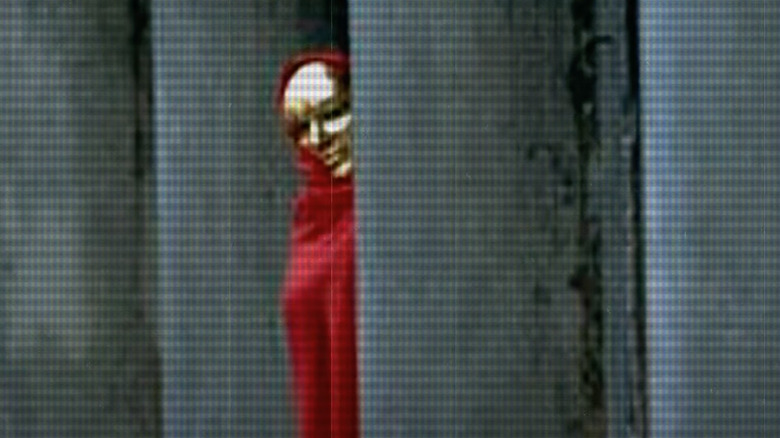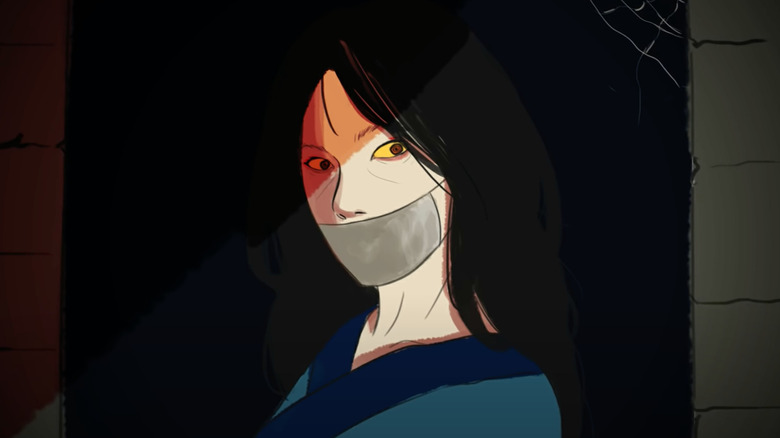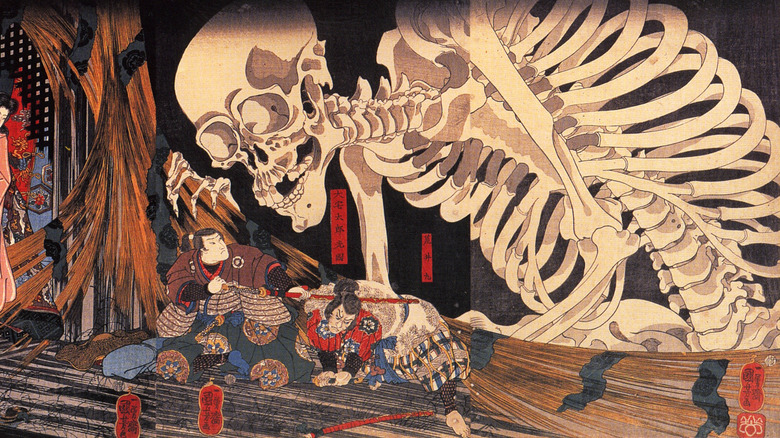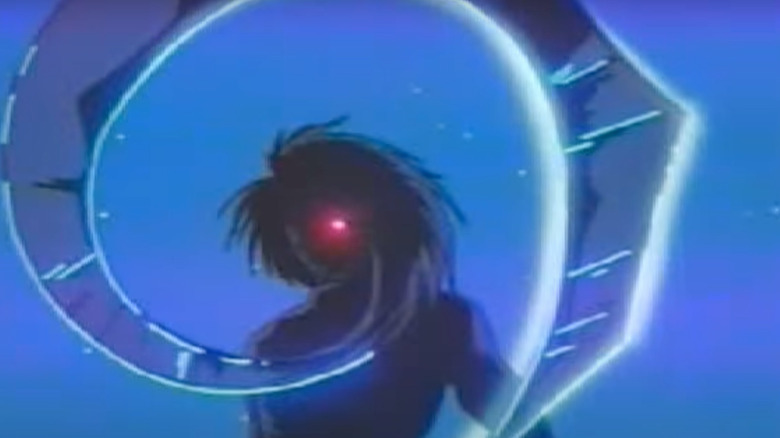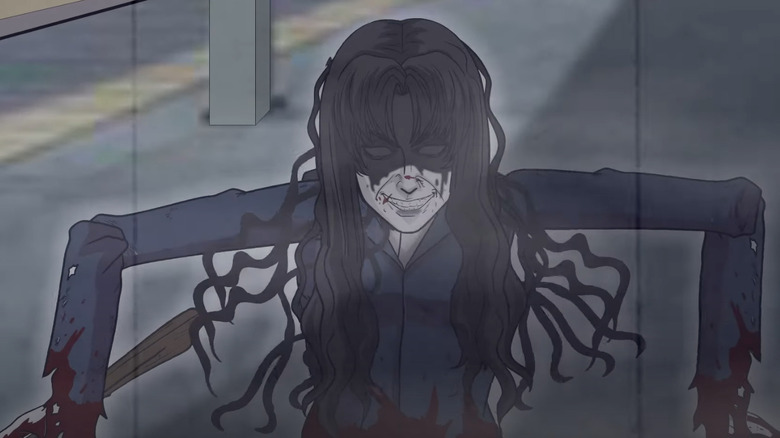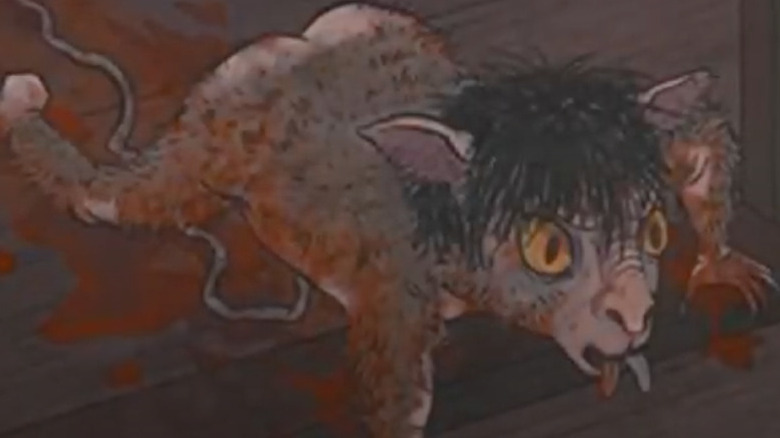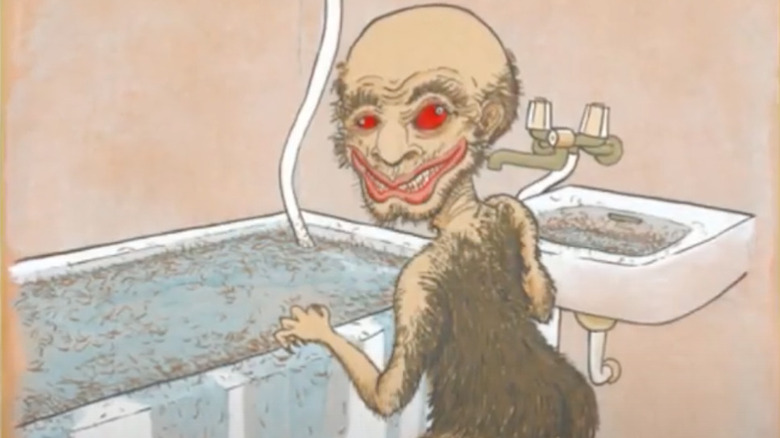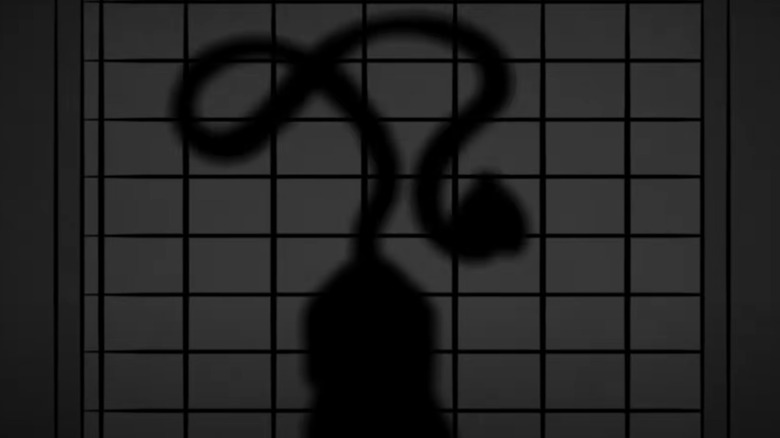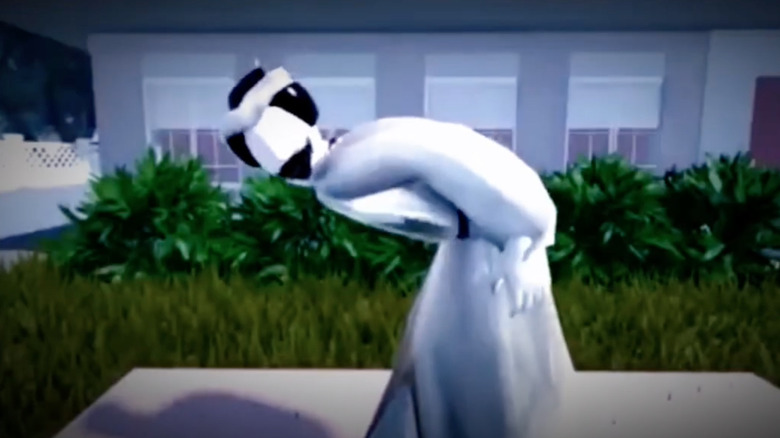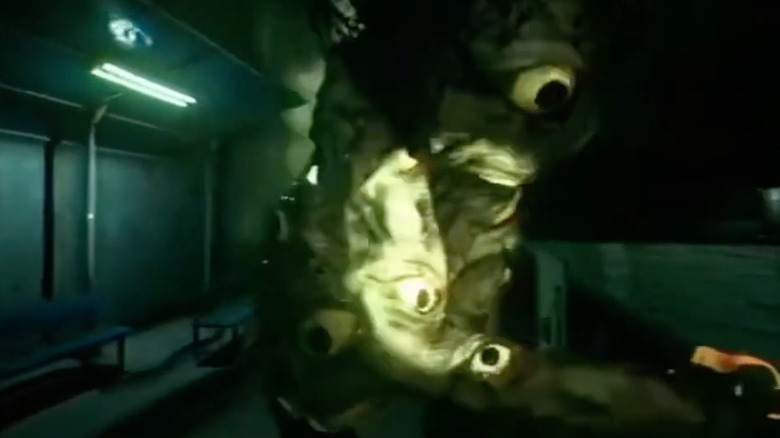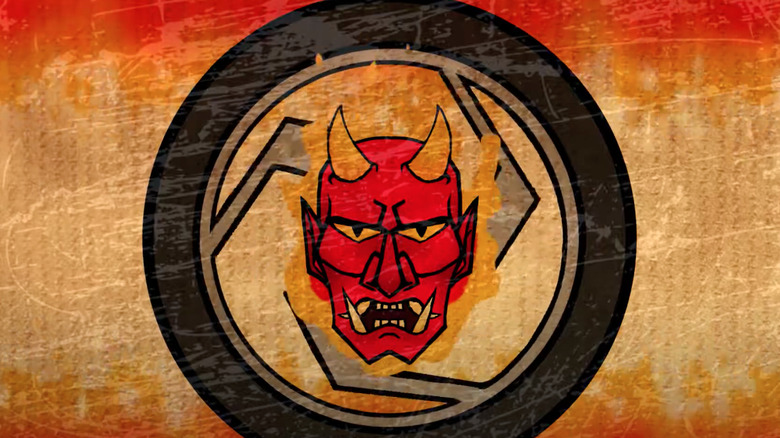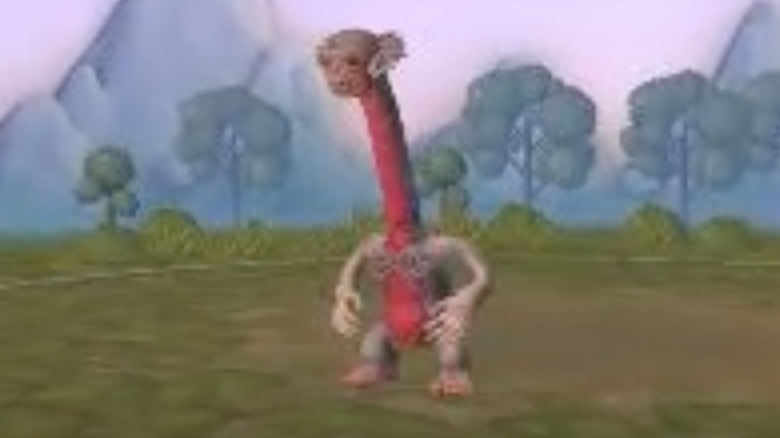The Most Terrifying Japanese Yokai
Any modern day horror movie aficionado probably thinks they've seen everything — monsters, demons, ghosts. Are there really any new ideas anymore? One quick glance at some of the terrifying Japanese yokai out there and the answer is a resounding yes. Yokai go beyond what western ghost stories traditionally hold, and that's because yokai themselves are unique to Japanese spirituality. According to "The Night Parade Of One Hundred Demons A Field Guide To Japanese Yokai" by yokai expert Matthew Meyer, yokai aren't just the Japanese equivalent of ghosts and monsters. The term also includes gods, ghosts, magical animals, transformed humans, urban legends, and other strange phenomena. Essentially meaning that all paranormal entities fall under this same blanket term.
Which, in turn, gives rise to all kinds of wonderful variants of yokai, some humanoid, some monstrous, and many of them just downright terrifying for an even wider array of reasons — fangs, talons, curses, lack of faces, and much, much more.
Interestingly, many yokai were once humans, too. Like western ghosts, they often come back when they have a grudge to bear or a bone to pick. Take Taira no Masakado, for instance, a samurai who had his head severed by his own family and, naturally, that head came back to reek sweet vengeance on anything and everything. Such is the nature of being a yokai in the sordid underbelly of the paranormal realm of Japan.
Here's a look at the most terrifying yokai you could ever encounter.
Aka Manto
The Japanese have a lot of yokai tied to toilets, and using the restroom, particularly in public places like schools, but no toilet-based yokai is as cruel as aka manto. The aka manto generally sticks to one particular stall, and should you be so unlucky as to choose that stall, she will give you a choice. After doing your business, she will offer you either red paper or blue and, unfortunately, one must be chosen. This is where the stories deviate a bit, depending on who you ask, according to yokai.com. If red paper is chosen, aka manto slices up the poor toilet user until they are soaked in their own blood. If blue paper is chosen, the aka manto instead sucks all the blood out of the person.
There are variations though, such as red paper leading to flaying and blue paper leading to strangling. Whatever the case, there is no right answer to the question, and in the end there is generally no way to survive. To circumvent this, some people bring their own toilet paper to public restrooms to try to avoid having to answer at all, which doesn't actually sound like a bad idea when considering the alternative.
Kuchisake Onna
This one is no fun whatsoever. According to "The Night Parade Of One Hundred Demons A Field Guide To Japanese Yokai" by Matthew Meyer, the kuchinasake onna is the lingering spirit of a mutilated woman who has come back to seek vengeance on any living person unfortunate to come across her. When she appears, she seems relatively benign, but so do practically all the others. Her mouth is covered by a mask or fan, and she asks the traveler if they think she's beautiful. This is the most important part, because your answer determines your fate, if only for a little while.
If you answer no, she slaughters you right then and there. If you answer yes, she reveals her mouth, which, Joker-like, is cut from ear to ear in a gruesome and bloody smile. Then she asks again if the traveler still thinks she's beautiful. If you stick to your guns and say yes again, she follows you home and brutally murders you in your sleep. If you say no to her second question, or react in a natural way, like screaming and/or running, she cuts your smile just like hers.
So however you handle this interaction, you're doomed, basically.
Gashadokuro
If ever there was a "standard" yokai, at least from Western conceptions, this may be it. Most yokai are pretty creative — spider women, flaming heads, legless apparitions — but the gashadokuro is just a giant skeleton, according to "The Night Parade Of One Hundred Demons A Field Guide To Japanese Yokai" by Matthew Meyer. It's composed of the remains of warriors who died in battle and were not given proper funerary rites. When that happens, the souls return to the bodies of the dead with a serious grudge against the living, and justifiably so. The problem is when all those remains band together and form this enormous skeletal fiend known as the gashadokuro.
With chattering teeth and creaky bones, the gashadokuro saunters about in the dead of night. They cannot be felled by mortal means, and will only cease to exist when their anger towards the living fizzles out. Which, given how many dead bodies compose this creature, as well as how much anger and resentment is contained in each individual soul, it can take awhile. While they do not require any sustenance, given their skeletal form, they still enjoy eating humans just for the fun of it.
Kamaitachi
Generally speaking, weasels are pretty cute. Itachi, the Japanese word for weasel, doesn't change that. Cute little orange coats and white bellies, like they were made to be mass produced as stuffed animals. Then you have the Kamaitachi, which, while still a cute little weasel, has some more nefarious intentions than casual survival.
The kamaitachi, or "sickle weasel," is just as the name suggests — weasels, like you'd see in the woods, but with sickles for claws. Needless to say, those sickles aren't just for decorative purposes. According to "The Night Parade Of One Hundred Demons A Field Guide To Japanese Yokai" by Matthew Meyer, they have fur as spiny as a hedgehog with claws as strong as steel. They're so fast that they can ride on the wind and their movement is invisible to the naked eye, which is where things get really slicey and dicey.
The kamaitachi attack in threes. The first one knocks a traveller down and slices their legs. The second one delivers thousands of awful cuts and wounds to the traveller for no apparent reason. The third one then uses magic to heal all the wounds. Meaning that, in the blink of an eye, a traveller will have gone to the brink of death and back and be none the wiser except for a good deal of pain and a few minor scratches. While the lasting impact of the kamaitachi isn't all that bad, the power they boast is pretty horrifying.
Teke teke
Teke teke is one of those yokai that looks terrifying enough as is, but then when it does its business to you, it's even more horrifying than it originally seemed. Teke teke appears as half a girl, literally. She's a young girl cut in half at the waist, crawling faster than you can run and finding you when you're alone and at your most vulnerable. Her name, according to yokai.com, comes from the sound she makes as she does whatever freakish crawl makes her go as fast as a running human being. If she catches up to you — and she will catch up with you — she uses her sickle to slice you in half at the waist, just like her. At least, that's what most of the legends say, but they don't all agree.
As far as how she got that way, the legends again don't agree, according to yokai.com. Some say it was an accident, train or otherwise, that cut her in half, some say that it was a suicide. Whatever the case, cold weather caused her wound to seal up and she died very, very slowly. Hence the anger she carries with her for the living.
Kekkai
This little yokai is just plain wrong. If a pregnant woman takes poor care of her body/baby, she better prepare to meet her kekkai. According to yokai.com, this yokai originated as a tale to explain away birth defects when modern medicine wasn't as understood as it is today. It was easier to say that a mother was killed by an evil spirit than by natural health problems that occur during childbirth.
Back to the kekkai, though. Sometimes, if a mother is experiencing issues during childbirth, rather than bear a human child, they will beat a kekkai, which has several descriptions, none any less horrifying than the other. Some say it looks more like a monkey, with hair growing in backwards. It also resembles just a lump of flesh that still roughly resembles a newborn baby. As far as tongues, it has two — one red, one white.
As if that wasn't enough, once a kekkai is born, it scampers all the way to the mother's house, where it burrows under and waits for her to come back. Once she does, the kekkai kills her. There are, however, ways to prevent this, according to yokai.com, such as putting screens around the house to prevent it from getting out.
Hyosube
Found primarily lurking around rivers and streams in Western Japan, Hyosube aren't fun to look at, but if you see them, it's already too late. They are short, squat humanoids with razor sharp teeth and claws, according to "The Night Parade Of One Hundred Demons A Field Guide To Japanese Yokai" by Matthew Meyer, and their appearance only gets worse from there. Since they are always smiling, they showcase those teeth all the time. Their skin is greasy and dirty and sheds regularly. Worse still is their love of finding a good bathtub. If they take a liking to your bathtub, you will wake up every morning to a tub full of scum and clumps of body hair.
Which isn't even the worst part. Meyer writes that anyone who so much as sees a Hyosube is stricken with a horrible and highly contagious fever that spreads so wildly it can cause an epidemic. Their level of contagion goes even further. The Hyosube has an evil laugh that, if heard by a human, will cause that human to uncontrollably laugh themselves before getting a violent fever and dying within hours. Essentially — there is nothing good that comes from a Hyosube.
And if that wasn't enough, their favorite food is eggplant.
Rokurokubi
During the day, the rokurokubi is nothing out of the ordinary. Just your regular woman, eating regular food, nothing to see here, according to "The Night Parade Of One Hundred Demons A Field Guide To Japanese Yokai" by Matthew Meyer. But once the sun sets for night time, get ready for a sight that you absolutely do not want to see. While the body of the rokurokubi sleeps, the head roams freely, lapping up lamp oil for sustenance. Some legends say the head completely detaches from the body, some say the neck is extendable and the head roams about that way.
The rokurokubi were once humans, but due to some sort of transgressions in life, either against a god or against a spouse, they've since been cursed with a roving head. While they aren't going to be any immediate danger to anyone, they are no less terrifying. No one wants to see a woman's head licking up their lamp oil in the dead of night.
Ohaguro bettari
Ohaguro bettari are interesting because they don't actually do any physical harm, but it's important not to discount the mental harm they could do to an unsuspecting bystander. According to "The Night Parade Of One Hundred Demons A Field Guide To Japanese Yokai" by Matthew Meyer, they look pretty enticing from a distance. Dressed in a kimono and whistling and beckoning to single young men, they wait until they're approached to reveal their true nature — a featureless face, no eyes or nose, save for a gaping mouth with solid black teeth. Once you see her true form, she cackles evilly — which feels like overkill at this point — and the terror is complete.
It must be said that for quite some time in Japan, dying the teeth black was a sign of beauty, according to Ancient Origins, and something done primarily among the aristocracy. Which is all well and good when that person still had other traditional features like eyes and a nose. When there's nothing there but a maw of a mouth with black teeth, the beauty quickly becomes pure terror.
Hyakume
The hyakume is perhaps the only yokai on this list that is actually out here doing good work, but that doesn't make him any less horrifying, if not because of appearance alone. With a name that literally translates to "one hundred eyes," you can guess what it looks like — a whole lot of eyes. According to "The Night Parade Of One Hundred Demons A Field Guide To Japanese Yokai" by Matthew Meyer, the hyakume is covered head to foot in yellow eyes, coupled with sagging, drooping skin that roughly resembles the shape of a man's body.
There's one more layer to their scariness, even if it's meant to be a positive interaction. Hyakume generally live in temples, and being shy, they will do their best to avoid human interaction. But, if a human does find their way onto a property managed by the hyakume, one of its eyes will float off and stick to that human as long as they are there, just to ensure that they don't do anything disrespectful. If that human is indeed there to do something bad, the hyakume tries to scare them away. They can't do much else besides that, but still — tons of eyes, pretty terrifying.
Wa Nyudo
If nothing else, at least these yokai are easy to spot. According to "The Night Parade Of One Hundred Demons A Field Guide To Japanese Yokai" by Matthew Meyer, wa nyudo appear as giant men's heads in the middle of ox cart wheels, rolling along roads and through towns. They come from the bowels of hell, but enjoy spending time on earth, wheeling about and looking for mortal souls to snack on. They primarily look for evil priests or criminals, take them back down to hell, and then come back up to earth to keep patrolling. While that seems like a noble enough calling, it doesn't explain all interactions with these monstrous beings.
For instance, consider the poor woman Meyer writes about, who looked out a window and saw a wa nyudo wheeling by. The yokai told her that she should be looking at her baby instead. Her baby started wailing, so she did, and found her baby lying in a pool of blood without legs. When she looked back to the wa nyudo, it was eating the legs of her baby. While it's not stated if she was wicked, it's probably safe to say that he baby wasn't. So while the wa nyudo may seem to be a wheel of flaming justice for the wicked, it's clearly more than a little wicked itself.
Most people hide from their doors and windows and decorate their house with charms to ward off the wa nyudo when it's coming to town.
Mikoshi Nyudo
The mikoshi nyudo is a particularly nefarious yokai because at first glance, it is nothing out of the ordinary. If anything, it is a welcome sight — a priest or monk, completely normal. They appear to lone travelers late at night, according to "The Night Parade Of One Hundred Demons A Field Guide To Japanese Yokai" by Matthew Meyer. As soon as the traveler looks at this harmless monk, however, the mikoshi nyuodo grows ridiculously tall, sprouts wild hair and razor sharp claws, and as that lone traveler, you may already be screwed. Everything that happens from that moment forward depends on how you react. Most reactions lead to immediate death, but there is one way to get out of this horrid end.
If you try to ignore this now-giant entity leering at you, the mikoshi nyudo will choose one of two deaths for you — being impaled by a bunch of bamboo spears, or being crushed. You don't get to choose, the mikoshi nyudo chooses. If you try to run away, you get the exact same fate.
The way to survive this encounter may sound simple, but when faced with an enormous demon priest, it may get a bit more complicated. You need simply look it from head to toe, according to Meyer, and say "You lost! I anticipated your trick!" This will cause the monster monk to disappear and you can pass freely.

